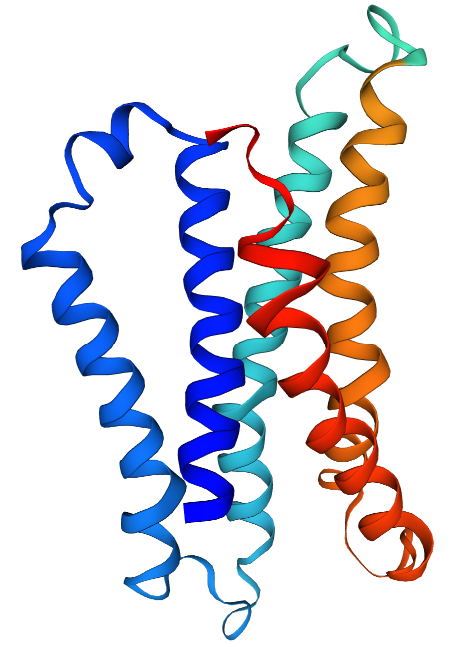Introduction of OTOP1
OTOP1, encoded by the gene OTOP1, is a transmembrane protein belonging to the otopetrin family. Only low expression of OTOP1 is observed in the reference dataset. OTOP1 has proton channel activity to enable the boosted diffusion of hydrogen ions and is also involved in many other biological processes, including biomineral tissue development, cellular response to insulin stimulus, negative regulation of interferon-gamma-mediated signaling pathway, and so on. No alternative transcript variant has been reported.
| Basic Information of OTOP1 | |
| Protein Name | Proton channel OTOP1 |
| Gene Name | OTOP1 |
| Aliases | Otopetrin-1 |
| Organism | Homo sapiens (Human) |
| UniProt ID | Q7RTM1 |
| Transmembrane Times | 12 |
| Length (aa) | 612 |
| Sequence | MLEGLGSPASPRAAASASVAGSSGPAACSPPSSSAPRSPESPAPRRGGVRASVPQKLAEMLSSQYGLIVFVAGLLLLLAWAVHAAGVSKSDLLCFLTALMLLQLLWMLWYVGRSSAHRRLFRLKDTHAGAGWLRGSITLFAVITVILGCLKIGYFIGFSECLSATEGVFPVTHSVHTLLQVYFLWGHAKDIIQSFKTLERFGVIHSVFTNLLLWANGVLNESKHQLNEHKERLITLGFGNITTVLDDHTPQCNCTPPTLCTAISHGIYYLYPFNIEYQILASTMLYVLWKNIGRKVDSHQHQKMQFKSDGVMVGAVLGLTVLAATIAVVVVYLIHIGRSKTKSESALIMFYLYAITLLMLMGAAGLAGIRIYRIDEKSLDESKNPARKLDSDLLVGTASGSWLISWGSILAILCAEGHPRYTWYNLPYSILAIVEKYIQNLFIFESIHREPEKLSEDIQTLRVVTVCNGNTMPLASSCPKSGGVARDVAPQGKDMPPAANGNVCMRESHDKEEEKQEESSWGGSPSPVRLPRFLQGNAKRKVLRNIAAFLFLCNISLWIPPAFGCRPEYDNGLEEIVFGFEPWIIVVNLAMPFSIFYRMHAAASLFEVYCKI |
Function of OTOP1 Membrane Protein
OTOP1 is indispensable for the formation of otoliths and otoconia, calcium carbonate biominerals within the mammalian inner ear that are necessary for the detection of gravity and linear acceleration. It is documented that OTOP1 acts as a sensor of the extracellular calcium concentration in/near vestibular supporting cells, and responds to ATP in the endolymph to increase intracellular calcium levels during otoconia mineralization. Besides, it is reported that mutations in the orthologous mouse OTOP1 gene are involved in agenesis of nonsyndromic otoconia and a consequent defect of balance. OTOP1 is involved in a counter-inflammatory pathway that weakens the inflammation of obesity-induced adipose tissue and acts as a significant regulator in maintaining homeostasis of metabolism in obesity. The orthologous mouse OTOP1 gene is also been found associated with obesity. Additionally, OTOP1 is a proton-selective channel that plays a role in modulating the concentration of cellular proton.
 Fig.1 A simulated partial structure of OTOP1 in the repository of SWISS-MODEL. (Bienert, 2017)
Fig.1 A simulated partial structure of OTOP1 in the repository of SWISS-MODEL. (Bienert, 2017)
Application of OTOP1 Membrane Protein in Literature
This article reveals that manipulation of the signaling components in the OTOP1-Gq/β-arrestin-1/CFTR complex may be an effective therapeutic strategy for male infertility.
This article suggests that the truncated constitutively active, but not the full-length GPR64 physically interacts with CaSR and attenuates the CaSR-mediated intracellular Ca2+ signaling and cAMP suppression in HEK293 cells. It indicates that GPR64 may be a physiologic regulator of PTH release that is dysregulated in parathyroid tumors, and suggests a role of GPR64 in pathologic calcium sensing in parathyroid hormone.
This article confirms that OTOP1 plays a crucial role in human male fertility and brings new insight into congenital obstructive azoospermia pathogenesis.
This report suggests that GPR64 can be activated through a tethered agonist sequence, which has previously identified as the Stachel sequence.
This article reveals that Gpr64 has a crucial role in the decidualization of endometrial stromal cells.
OTOP1 Preparation Options
In order to provide high-quality membrane protein preparation services, we have developed the versatile Magic™ membrane protein production platform. Our experienced scientists will do their best to help you find a perfect match in your required formats. Aided by our versatile Magic™ anti-membrane protein antibody discovery platform, we also provide customized anti-OTOP1 antibody development services.
Creative Biolabs is dedicated to providing first-class membrane protein production service using a variety of strategies. Based on our leading-edge platform, we have successfully produced, purified, stabilized and characterized many challenging membrane protein targets for global customers. If you are interested in the service we can provide, please feel free to contact us for more information.
Reference
All listed services and products are For Research Use Only. Do Not use in any diagnostic or therapeutic applications.